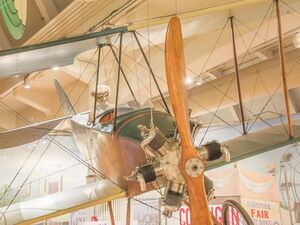Engineering:Laird B-4
| Laird B-4 | |
|---|---|

| |
| The Laird B-4 of 1915, at the Henry Ford Museum | |
| Role | Homebuilt aircraft |
| National origin | United States |
| Designer | Emil Matthew Laird |
| Introduction | 1915 |
| Number built | 1 |
The Laird B-4,[1] aka Laird 1915 biplane, was the fourth aircraft built by Matty Laird in the United States of America . It was an excellent aerobatic aircraft and was used very effectively in performances by Laird, as well as by Katherine Stinson during her tour of Japan and China .
Design and development
During the period when Matty Laird was performing as a barnstorming pilot, he designed this as an aerobatic aircraft for his own use. He built the aircraft with assistance from his brother Charles and friend George E. “Buck” Weaver. The aircraft was constructed from wood, fabric, and wire bracing. It was powered by a 45 hp (34 kW) six-cylinder Anzani radial engine. Laird was approximately 20 years old when he built the aircraft.[2][3][4]
Laird referred to the aircraft as “My Anzani-powered machine” as well as “Boneshaker” because the powerful engine generated such strong vibrations in the airplane.[2]
Operational history
The aircraft's power and structural strength made it excellent for aerobatics, and Laird's flying skill enabled him to take advantage of the aircraft's characteristics and to perform several challenging maneuvers. For instance, he performed the loop-the-loop, which only a few American pilots could perform prior to World War I. Laird's performances in the aircraft generated significant public awareness of him and the aircraft.[2][3]
Laird loaned the aircraft to Katherine Stinson for her 1916-1917 flying exhibition tour to Japan and China. This tour created tremendous attention for Stinson and for Laird's aircraft within and beyond the two countries.[3][5]
Aircraft on display
Laird donated the aircraft to the Henry Ford Museum and it is on display there.[6]
Specifications (1915 Laird Biplane)
Data from Heroes of the Sky at Henry Ford Museum, The Planes: 1915 Laird Biplane[7]
General characteristics
- Crew: 1
- Capacity: 1 pax
- Length: 19 ft 5 in (5.92 m)
- Wingspan: 25 ft 4 in (7.72 m)
- Empty weight: 600 lb (272 kg)
- Powerplant: 1 × Anzani 6-cylinder air-cooled radial piston engine, 45 hp (34 kW)
- Propellers: 2-bladed fixed-pitch propeller
Performance
References
- ↑ Eckland, K.O.. "American airplanes: Laird". http://aerofiles.com/_laird.html.
- ↑ 2.0 2.1 2.2 "Famous Flyers: "Matty" Laird, Super Sleuth". FAA Aviation News (Federal Aviation Administration) 11 (11): 10–11. March 1973. https://books.google.com/books?id=9LbJH653hVIC&dq=editions%3Aku7bR_YYKFcC&pg=RA10-PA10.
- ↑ 3.0 3.1 3.2 Elliot, Robert; Escallon, Ed (July 1976). "A Silver Eagle: A Biography of E.M. "Matty" Laird". The Vintage Airplane (Antique/Classic Division of The Experimental Aircraft Association) 4 (7): 15–22. https://issuu.com/vintageeaa/docs/va-vol-4-no-7-july-1976.
- ↑ "Heroes of the Sky at Henry Ford Museum, The Planes: 1915 Laird Biplane". http://ophelia.sdsu.edu:8080/henryford_org/03-25-2015/exhibits/heroes/barnstormers/laird.asp.html.
- ↑ "'Goddess of the Skies': how one woman changed an industry". January 26, 2017. https://news.unm.edu/news/goddess-of-the-skies-:-how-one-woman-changed-an-industry.
- ↑ Sign at museum exhibit.
- ↑ "Heroes of the Sky at Henry Ford Museum, The Planes: 1915 Laird Biplane". http://ophelia.sdsu.edu:8080/henryford_org/03-25-2015/exhibits/heroes/barnstormers/laird.asp.html.
 |

